Related Research Articles

The Reich Security Main Office was an organization subordinate to Heinrich Himmler in his dual capacity as Chef der Deutschen Polizei and Reichsführer-SS, the head of the Nazi Party's Schutzstaffel (SS). The organization's stated duty was to fight all "enemies of the Reich" inside and outside the borders of Nazi Germany.
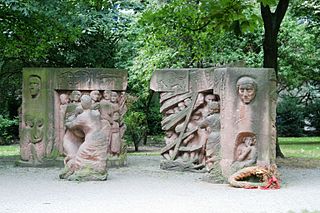
The Rosenstrasse protest on Rosenstraße took place in Berlin during February and March 1943. This demonstration was initiated and sustained by the non-Jewish wives and relatives of Jewish men and Mischlinge, those of mixed Jewish and Aryan heritage, who had been arrested and targeted for deportation, based on the racial policy of Nazi Germany. The protests, which occurred over the course of seven days, continued until the men being held were released by the Gestapo. The Rosenstrasse protest is considered to be a significant event in German history as it is the only mass public demonstration by Germans in the Third Reich against the deportation of Jews. In describing the protests, German Foreign Minister Joschka Fischer states, "There were demonstrations, public protests against random arrests, - first dozens, then hundreds, then thousands of women, who demanded in unison "Give us back our men!" The protest by the women of the Rosenstrasse made the Nazi regime retreat as German propaganda minister Joseph Goebbels order for a release of the men, including approximately 1,800 Berlin Jews. The Gestapo in their "Final Solution" had herded together these men into the Jewish community house on Rosenstrasse near Alexanderplatz, who were then subsequently freed by order of Goebbels."
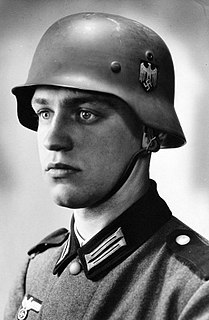
Werner Goldberg was a German who was of half Jewish ancestry, or Mischling in Nazi terminology, who served briefly as a soldier during World War II. His image appeared in the Berliner Tageblatt as "The Ideal German Soldier", and was later used in recruitment posters for the Wehrmacht.

Rassenschande or Blutschande was an anti-miscegenation concept in Nazi German racial policy, pertaining to sexual relations between Aryans and non-Aryans. It was put into practice by policies like the Aryan certificate requirement, and later by anti-miscegenation laws such as the Nuremberg Laws, adopted unanimously by the Reichstag on 15 September 1935. Initially, these laws referred predominantly to relations between Germans classified as so-called 'Aryans' and non-Aryans, regardless of citizenship. In the early stages the culprits were targeted informally, and then later on punished systematically by a repressive legal apparatus.
Social Outsiders in Nazi Germany is a book edited by Robert Gellately and Nathan Stoltzfus. It is a collection of essays offering the history of those branded "social outsiders" in Nazi Germany.

The Nuremberg Laws were antisemitic and racist laws that were enacted in Nazi Germany on 15 September 1935, at a special meeting of the Reichstag convened during the annual Nuremberg Rally of the Nazi Party. The two laws were the Law for the Protection of German Blood and German Honour, which forbade marriages and extramarital intercourse between Jews and Germans and the employment of German females under 45 in Jewish households; and the Reich Citizenship Law, which declared that only those of German or related blood were eligible to be Reich citizens. The remainder were classed as state subjects without any citizenship rights. A supplementary decree outlining the definition of who was Jewish was passed on 14 November, and the Reich Citizenship Law officially came into force on that date. The laws were expanded on 26 November 1935 to include Romani and Black people. This supplementary decree defined Romanis as "enemies of the race-based state", the same category as Jews.
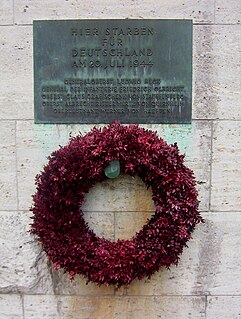
German resistance to Nazism included opposition by individuals and groups in Germany to the Nazi regime between 1933 and 1945, most of which engaged in active resistance, including attempts to remove Adolf Hitler from power by assassination or by overthrowing his established regime.
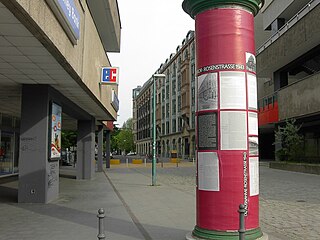
Fabrikaktion is the term for the roundup of the last Jews deported from Berlin, beginning in 27 February 1943. Most of the remaining Jews were working at Berlin plants or for the Jewish welfare organization. The term Fabrikaction was coined by survivors after World War II; the Gestapo had designated the plan "Große Fabrik-Aktion". While the plan was not restricted to Berlin, it later became most notable for catalyzing the Rosenstrasse protest, the only mass public demonstration of German citizens which contested the Nazi government's deportation of the Jews.
Robert Gellately is a Canadian academic and noted authority on the history of modern Europe, particularly during World War II and the Cold War era.
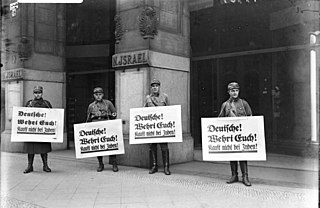
The Nazi boycott of Jewish businesses in Germany began on April 1, 1933, and was claimed to be a defensive reaction to the anti-Nazi boycott, which had been initiated in March 1933. It was largely unsuccessful, as the German population continued to use Jewish businesses, but revealed the intent of the Nazis to undermine the viability of Jews in Germany.

Hertha Pauli was an Austrian journalist, writer and actress.
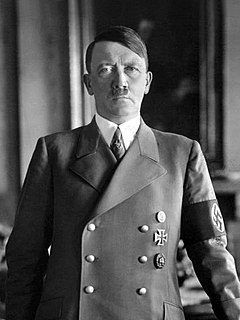
Parliamentary elections were held in Germany on 29 March 1936. They took the form of a single-question referendum, asking voters whether they approved of the military occupation of the Rhineland and a single party list for the new Reichstag composed exclusively of Nazis and nominally independent 'guests' of the party. Like previous votes in the Nazi era, it was rigged, with a claimed turnout of 99% and 98.8% voting in favour. In a publicity stunt, a number of voters were packed aboard the airships Graf Zeppelin and Hindenburg, which flew above the Rhineland as those aboard cast their ballots.
Christof Mauch is a German historian, presently director of the Rachel Carson Center for Environment and Society in Munich, Germany, and since 2007 professor of American Cultural History and Transatlantic Relations at Ludwig Maximilian University of Munich. From 1999 to 2007 Christof Mauch was the director of the German Historical Institute in Washington D.C.. Mauch received his Dr. phil. in Modern German Literature from the University of Tübingen in 1990, and his Dr. phil. in Modern History in 1998 from the University of Cologne. He has published and edited many books in the fields of U.S. and German History and Environmental History. From 2009 to 2011 Christof Mauch was Chair of the Board of Directors of the International Consortium of Environmental History Organizations (ICEHO) and from 2011-2013 President of the European Society for Environmental History. In May 2013 he was appointed Honorary Professor at Renmin University, Beijing, China.In the same year he was awarded the Carl-von-Carlowitz Prize of Germany's Council for Sustainable Development, and in 2017 he received the Award for a Distinguished Career in Public Environmental History from the American Society for Environmental History.
The Association of German National Jews was a German Jewish organization during the Weimar Republic and the early years of Nazi Germany that eventually came out in support of Adolf Hitler.

A referendum on the Anschluss with Germany was held in German-occupied Austria on 10 April 1938, alongside one in Germany. German troops had already occupied Austria one month earlier, on 12 March 1938. The official result was reported as 99.73% in favour, with a 99.71% turnout.

Gustav Adolf Nosske was a German lawyer and SS-Obersturmbannführer. In 1941–42, he commanded Einsatzkommando 12 within Einsatzgruppe D, under the command of Otto Ohlendorf. Tried in the Einsatzgruppen Trial in 1948, Nosske was sentenced to life imprisonment. He was released early in 1955.
Hans Meiser was a German Protestant theologian, pastor and from 1933 to 1955 the first 'Landesbischof' of the Evangelical Lutheran Church in Bavaria.
The Witten Women's Protest was conducted to demonstrate against a specific policy of the Nazi regime. After being evacuated from the city of Witten due to the dangers of Allied bombing raids, women and children were moved to the countryside in Baden, away from their husbands and homes. Many women returned to Witten and their homes despite these regulations. By traveling back and forth between their homes and evacuation sites, they were seen by the Nazi government to be an additional burden on already over-stressed wartime transportation systems. The Nazi Party Gauleiter of Westphalia South, Albert Hoffmann, declared that women from his region would not receive their food ration cards except in Baden or other designated evacuation sites. The protest occurred on October 11, 1943 and achieved the aims of the protesters, backed by a ruling by Hitler in January 1944, to allow the distribution of ration cards regardless of where the women were. According to the SD secret police there were estimated to be 300 women in the Witten Women's Protest. The Witten Women's Protest and the Nazi appeasement of the protesters prompted Goebbels to worry on November 2, 1943 that the regime was losing power by giving in repeatedly to Germans gathered on the streets in dissent. The protest weighed decisively on Hitler's decision in January 1944, that no Nazi official could manipulate ration card distribution as means of enforcing evacuation regulations.
The Crucifix Decrees were part of the Nazi Regime’s efforts to secularize public life. For example, crucifixes throughout public places like schools were to be replaced with the Fuhrer’s picture. The Crucifix Decrees throughout the years of 1935 to 1941 sparked protests against removing crucifixes from traditional places. Protests notably occurred in Oldenburg in 1936, Frankenholz (Saarland) and Frauenberg in 1937, and in Bavaria in 1941. These incidents prompted Nazi party leaders to back away from crucifix removals in 1941.
Jews who were married to non-Jews had a greater chance of surviving the Holocaust. In Germany, Jews in "privileged mixed marriages" were exempt from some anti-Jewish laws. All intermarried Jews in Greater Germany were generally exempted from deportation during the Holocaust until early 1945, which enabled 90 percent to survive. However, they faced strong pressure from Nazi authorities to divorce, which would end the protection for the Jewish partner. A famous event is the 1943 Rosenstrasse protest, in which non-Jewish women protested in Berlin after their Jewish husbands were arrested. It is unclear whether this action prevented the deportation of their husbands.
References
- 1 2 3 "Nathan Stoltzfus". Department of History. Florida State University . Retrieved 26 April 2021.
- ↑ The First Five Years: 1983–1988 and Plans for the Future: President's report (PDF) (Report). The Albert Einstein Institution. 1988. pp. 11, 13–14, 35. Retrieved 26 April 2021.
- ↑ "Helden ohne Namen". Einestages/Der Spiegel. Retrieved 2009-12-31.
- ↑ "Rosenstraße - h-german discussion forum". July 2004. Retrieved 2009-12-31.
- ↑ Geyer, Michael (1998). "Resistance of the Heart: Intermarriage and the Rosenstrasse Protest in Nazi Germany". Journal of Church and State. Archived from the original on 2013-10-05.
- 1 2 Stoltzfus, Nathan (1996). Resistance of the heart: intermarriage and the Rosenstrasse protest in Nazi Germany. New York: W.W. Norton. ISBN 978-0-8135-2909-7.
- ↑ Joschka Fischer, translation into English by Christine Schurtman. "Foreword to "Resistance of the Heart"" . Retrieved 2009-12-31.
- ↑ Die Zeit (German)
- ↑ Gellately, Robert; Stoltzfus, Nathan (2001). Social outsiders in Nazi Germany. Princeton, N.J.: Princeton University Press. ISBN 978-0-691-08684-2.
- ↑ Mauch, Christof; Stoltzfus, Nathan; Weiner, Douglas R. (2006). Shades of green: environmental activism around the globe. Lanham, Md.: Rowman & Littlefield. ISBN 978-0-7425-4648-6.
- ↑ E. Thalhammer, Kristina; L. O'Loughlin, Paula; Glazer, Myron; Glazer, Penina Migdal; McFarland, Sam; Stoltzfus, Nathan; Toffey Shepela, Sharon (25 September 2007). Courageous Resistance: The Power of Ordinary People. Palgrave Macmillan. ISBN 978-1-4039-8498-2.
- ↑ Stoltzfus, Nathan; Friedlander, Henry (2008). Nazi crimes and the law. Washington, D.C.: German Historical Institute. ISBN 978-0-521-89974-1.